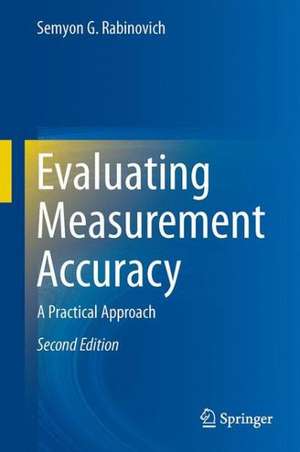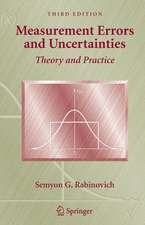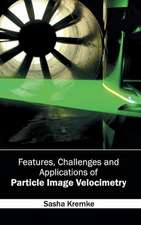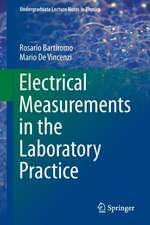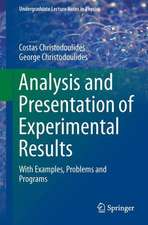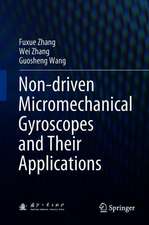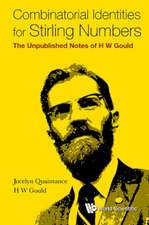Evaluating Measurement Accuracy: A Practical Approach
Autor Semyon G Rabinovichen Limba Engleză Hardback – 3 iul 2013
This new edition adds a method for estimating accuracy of indirect measurements with independent arguments, whose development Dr. Rabinovich was able to complete very recently. This method, which is called the Method of Enumeration, produces estimates that are no longer approximate, similar to the way the method of reduction described in the first edition removed approximation in estimating uncertainty of indirect measurements with dependent arguments. The method of enumeration completes addressing the range of problems whose solutions signify the emergence of the new theory of accuracy of measurements. A new method is added for building a composition of histograms, and this method forms a theoreticalbasis for the method of enumeration.Additionally, as a companion to this book, a concise practical guide that assembles simple step-by-step procedures for typical tasks the practitioners are likely to encounter in measurement accuracy estimation is available at SpringerLink.
| Toate formatele și edițiile | Preț | Express |
|---|---|---|
| Paperback (1) | 586.18 lei 38-44 zile | |
| Springer – 4 aug 2015 | 586.18 lei 38-44 zile | |
| Hardback (1) | 648.56 lei 6-8 săpt. | |
| Springer – 3 iul 2013 | 648.56 lei 6-8 săpt. |
Preț: 648.56 lei
Preț vechi: 763.01 lei
-15% Nou
Puncte Express: 973
Preț estimativ în valută:
124.14€ • 134.89$ • 104.35£
124.14€ • 134.89$ • 104.35£
Carte tipărită la comandă
Livrare economică 21 aprilie-05 mai
Preluare comenzi: 021 569.72.76
Specificații
ISBN-13: 9781461467168
ISBN-10: 1461467160
Pagini: 260
Ilustrații: XVIII, 313 p. 22 illus.
Dimensiuni: 155 x 235 x 25 mm
Greutate: 0.64 kg
Ediția:2nd ed. 2013
Editura: Springer
Colecția Springer
Locul publicării:New York, NY, United States
ISBN-10: 1461467160
Pagini: 260
Ilustrații: XVIII, 313 p. 22 illus.
Dimensiuni: 155 x 235 x 25 mm
Greutate: 0.64 kg
Ediția:2nd ed. 2013
Editura: Springer
Colecția Springer
Locul publicării:New York, NY, United States
Public țintă
ResearchCuprins
General Concepts in the Theory of Measurements.- Measuring Instruments and Their Properties.- Statistical Methods for Experimental Data Processing.- Direct Measurements.- Indirect Measurements.- Combined and Simultaneous Measurements.- Combining the Results of Measurements.- Examples of Measurements and Measurement Data Processing.- The International Vocabulary of Metrology and the Guide to the Expression of Uncertainty in Measurement – Analysis, Criticism, and Recommendations.
Notă biografică
The goal of Evaluating Measurement Accuracy: A Practical Approach is to present methods for estimating the accuracy of measurements performed in industry, trade, and scientific research. From developing the theory of indirect measurements to proposing new methods of reduction, transformation, and enumeration, this work encompasses the full range of measurement data processing. It includes many examples that illustrate the application of general theory to typical problems encountered in measurement practice. As a result, the book serves as an inclusive reference work for data processing of all types of measurements: single and multiple, combined and simultaneous, direct (both linear and nonlinear), and indirect (both dependent and independent). It is a working tool for experimental scientists and engineers of all disciplines who work with instrumentation. It is also a good resource for natural science and engineering students and for technicians performing measurements in industry.
A key feature of the book is a new general theory of measurements that is both well-grounded and oriented towards real-life needs of measurement practitioners. Although the traditional theory focuses on multiple measurements, single measurements are the ones most commonly used. This book presents methods for evaluating accuracy of single measurements and answers other fundamental questions not addressed adequately by the traditional theory, such as how to combine various components o
f measurement inaccuracy when evaluating the complete uncertainty of a measurement result. For its second edition, the book adds significant new material to incorporate recent metrological developments and expand coverage, including:
· The new method of enumeration of experimental data processing for independent indirect multiple measurements which is precise and does not rely on questionable assumptions.
· The analysis of reliability of estimates of statistical parameters of samples from a normal distribution.
· A significantly expanded analysis of two fundamental documents in modern metrology, the International Vocabulary of Metrology and the Guide to the Expression of Uncertainty in Measurement.
· Completely rewritten sections devoted to accuracy of a single measurement taken with a chain of instruments and the Monte Carlo method.
A key feature of the book is a new general theory of measurements that is both well-grounded and oriented towards real-life needs of measurement practitioners. Although the traditional theory focuses on multiple measurements, single measurements are the ones most commonly used. This book presents methods for evaluating accuracy of single measurements and answers other fundamental questions not addressed adequately by the traditional theory, such as how to combine various components o
f measurement inaccuracy when evaluating the complete uncertainty of a measurement result. For its second edition, the book adds significant new material to incorporate recent metrological developments and expand coverage, including:
· The new method of enumeration of experimental data processing for independent indirect multiple measurements which is precise and does not rely on questionable assumptions.
· The analysis of reliability of estimates of statistical parameters of samples from a normal distribution.
· A significantly expanded analysis of two fundamental documents in modern metrology, the International Vocabulary of Metrology and the Guide to the Expression of Uncertainty in Measurement.
· Completely rewritten sections devoted to accuracy of a single measurement taken with a chain of instruments and the Monte Carlo method.
Textul de pe ultima copertă
The goal of Evaluating Measurement Accuracy: A Practical Approach is to present methods for estimating the accuracy of measurements performed in industry, trade, and scientific research. From developing the theory of indirect measurements to proposing new methods of reduction, transformation, and enumeration, this work encompasses the full range of measurement data processing. It includes many examples that illustrate the application of general theory to typical problems encountered in measurement practice. As a result, the book serves as an inclusive reference work for data processing of all types of measurements: single and multiple, combined and simultaneous, direct (both linear and nonlinear), and indirect (both dependent and independent). It is a working tool for experimental scientists and engineers of all disciplines who work with instrumentation. It is also a good resource for natural science and engineering students and for technicians performing measurements in industry.
A key feature of the book is a new general theory of measurements that is both well-grounded and oriented towards real-life needs of measurement practitioners. Although the traditional theory focuses on multiple measurements, single measurements are the ones most commonly used. This book presents methods for evaluating accuracy of single measurements and answers other fundamental questions not addressed adequately by the traditional theory, such as how to combine various components o
f measurement inaccuracy when evaluating the complete uncertainty of a measurement result. For its second edition, the book adds significant new material to incorporate recent metrological developments and expand coverage, including:
· The new method of enumeration of experimental data processing for independent indirect multiple measurements which is precise and does not rely on questionable assumptions.
· The analysis of reliability of estimates of statistical parameters of samples from a normal distribution.
· A significantly expanded analysis of two fundamental documents in modern metrology, the International Vocabulary of Metrology and the Guide to the Expression of Uncertainty in Measurement.
· Completely rewritten sections devoted to accuracy of a single measurement taken with a chain of instruments and the Monte Carlo method.
A key feature of the book is a new general theory of measurements that is both well-grounded and oriented towards real-life needs of measurement practitioners. Although the traditional theory focuses on multiple measurements, single measurements are the ones most commonly used. This book presents methods for evaluating accuracy of single measurements and answers other fundamental questions not addressed adequately by the traditional theory, such as how to combine various components o
f measurement inaccuracy when evaluating the complete uncertainty of a measurement result. For its second edition, the book adds significant new material to incorporate recent metrological developments and expand coverage, including:
· The new method of enumeration of experimental data processing for independent indirect multiple measurements which is precise and does not rely on questionable assumptions.
· The analysis of reliability of estimates of statistical parameters of samples from a normal distribution.
· A significantly expanded analysis of two fundamental documents in modern metrology, the International Vocabulary of Metrology and the Guide to the Expression of Uncertainty in Measurement.
· Completely rewritten sections devoted to accuracy of a single measurement taken with a chain of instruments and the Monte Carlo method.
Caracteristici
New edition includes a new chapter devoted to the analysis of the International Vocabulary of Metrology (VIM) and the Guide for Uncertainty in Measurement (GUM) Includes a section devoted to the comparison of standard deviation with confidence interval as an indication of uncertainty of the mean of a sample Provides a comprehensive reference for measurement data processing that encompasses all types of measurements Proposes methods for measurement data processing that account for the metrological characteristics of the measuring instruments used A new method is added for building a composition of histograms, resulting in a the “Method of Enumeration” Includes supplementary material: sn.pub/extras
Descriere
Descriere de la o altă ediție sau format:
This work encompasses the full range of measurement data processing. It includes many solid examples that exemplify typical problems encountered in measurement practice, from general theory to practical applications.
This work encompasses the full range of measurement data processing. It includes many solid examples that exemplify typical problems encountered in measurement practice, from general theory to practical applications.
